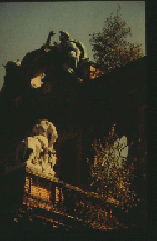

Still bound by very complex regulations, West Berlin began to rebuild in earnest. It was given special treatment by West Germany and by the Allies. It's survival became a symbol of Western commitment against Soviet-style communism. Money was pumped in, industries revived, a new University created (Freie Universität), since the Humboldt University in East Berlin was dominated by Communist professors and principles. But the East German Government, certain that West Berlin would eventually fall to them, was richly inventive in tactics of intimidation. Highways were blocked for hours or days at a time, as were canal and rail corridors. Finally, they blockaded the city totally. The Americans - specifically, General Lucius Clay, - invented the Air Lift. For over a year, one B-29 after another flew into Tempelhof Airport and supplied the city until the blockade was lifted. Americans were heroes to West Berliners during the late 'forties and well beyond. Berlin cleaned up the war mess, grew and prospered, not quite as dynamically as West Germany,but not too far behind.
During my student days in Berlin thousands of refugees came over every day in the summer of 1960. Most of my student friends during that era were originally from East Germany. We studied at the Free University, rode our bicycles through Berlin's huge wooded areas in the west, swam in the several lakes, went to the theater, bought books, wrote poetry, ateEisbein and drank beer. In the West, there were wonderful productions of classics, experimental theaters, art galleries and fine museums.
The world was split and here in this one city, you could walk or commute from one half to the other. In East Berlin we visited the art museums, went to the theater and bookstores. Many of the books in my German collection were purchased in the late '50s in East Berlin. The two parts of the city vied with each other culturally: In East Berlin, the main attraction was the Berliner Ensemble, a theater where we saw productions of Mother Courage and The Rise and Fall of the Third Reich that had been done by Bertolt Brecht himself before he died.
As we walked there along Unter den Linden, along the avenue that had formerly housed great embassies and official buildings of the German Empire, we saw ruins to our right and to our left. Such buildings that had survived or been rebuilt were draped with banners proclaiming the Final Victory of Socialism and theVictory of the Greater Moral Idea. During this period and beyond, Berlin was the spy capitol of the world. - Culturally,in the 'fifties, before the Cold War really got started, there was a kind of intellectual contest there between the West and East. And it was taking place in the ruined capital of the Third Reich, not in liberated Paris or victorious London.

Proceed to Part 3. The Raising of the Wall or, switch to another Part:
1. Berlin at the End of WWII
2: The First Postwar Decade
4. West Berlin thrives
5. East Berlin, a tourist attraction
6. East Germany during the Wall
7. Bringing down the Wall from within
8. East meets West
9. East German Problems
10. The Road to Unification